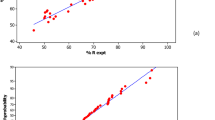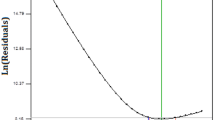Abstract
Dibenzothiophene (DBT) is a recalcitrant organic sulfur compound which remains in the crude oil after hydrodesulfurization (HDS) process and can be removed by biodesulfurization (BDS). The objective of this study was the isolation of novel strain capable more BDS rate and optimization of DBT removal by both growing and resting cells. Response surface Methodology (RSM) was applied for evaluating the interactive effects of three independent factors including DBT concentration, temperature and pH. The three factors Box-Benken design with three center points was performed to generate the optimum condition for DBT removal by growing cells in aqueous medium and resting cells in biphasic medium. Among the isolated bacteria from oil-contaminated soil, a gram-positive, non-spore forming isolate designated PD1 showed the high BDS rate and capable to convert the DBT to 2-hydroxybiphenyl (2-HBP) as the final product. Analysis of variance (ANOVA) demonstrated that all of the studied parameters in the growing cells system showed significant effect on BDS rate, while in the resting cells effect of pH was not significant (P > 0.05). Maximum 2-HBP production (0.21 mM) by growing cells of PD1 strain was obtained at 0.38 mM initial DBT concentration, pH 6.88 and temperature of 27.57°C. For resting cells, maximum BDS activity of PD1 strain was determined as 0.46 μM 2-HBP/min g DCW at optimum pH 6.29, temperature of 26.13°C and DBT concentration of 7.73 mM. The BDS efficiency of Rhodococcus erythropolis PD1 (NCBI Gene Bank Accession no. JX625154) was increased by setting each factor at the optimum level.
Similar content being viewed by others
References
Wang, Z. and Stout, S.A., Oil Spill Environmental Forensics: Fingerprinting and Source Identification, Toronto: Elsevier, 2006.
Nuhu, A.A., Bio-catalytic desulfurization of fossil fuels: a mini review, Rev. Environ. Sci. Biotechnol., 2013, vol. 12, pp. 9–23.
Derikvand, P., Etemadifar, Z., and Biria, D., Taguchi optimization of dibenzothiophene biodesulfurization by Rhodococcus erythropolis R1 immobilized cells in a biphasic system, Int. Biodeter. Biodegr., 2014, vol. 86, pp. 343–348.
Ma, X., Sun, L., and Song, C., A new approach to deep desulfurization of gasoline, diesel fuel and jet fuel by selective adsorption for ultra-clean fuels and for fuel cell applications, Catal. Today, 2002, vol. 77, pp. 107–116.
Borgne, S.L. and Quintero, R., Biotechnological processes for the refining of petroleum, Fuel Process Technol., 2003, vol. 81, pp. 155–169.
Gou, Z., Liu, H., Luo, M., Li, S., Xing, J., and Chen, J., Isolation and identification of nondestructive desulfurization bacterium, Sci. China Ser. B, vol. 45, pp. 521–531.
Ting, M., The desulfurization pathway in Rhodococcus, Microbiol. Monographs, 2010, vol. 16, pp. 207–230.
Yan, H., Kishimoto, M., Omasa, T., Katakura, Y., Suga, K.I., Okumura, K., and Yoshikawa, O., Increase in desulfurization activity of Rhodococcus erythropolis KA2-5-1 using ethanol feeding, J. Biosci. Bioeng., 2000, vol. vol. 89, pp. 361–366.
Derikvand, P., Etemadifar, Z., and Saber, H., Optimization of nicotinamide and riboflavin in the biodesulfurization of dibenzothiophene using response surface methodology, Bio. J. Micro., 2013, vol. 4, pp. 35–40.
Calzada, J., Alcon, A., Santos, V.E., and Garcia-Ochoa, F., Mixtures of Pseudomonas putida CECT 5279 cells of different ages: optimization as biodesulfurization catalyst, Process. Biochem., 2011, vol. 46, pp. 1323–1328.
Zhang, S.H., Chen, H., and Li, W., Kinetic analysis of biodesulfurization of model oil containing multiple alkyl dibenzothiophenes, Appl. Microbiol. Biotechnol., 2013, vol. 97, pp. 2193–2200.
Khurana, S., Kapoor, M., Gupta, S., and Kuhad, R., Statistical optimization of alkaline xylanase production from Streptomyces violaceoruber under submerged fermentation using response surface methodology, Indian J. Microbiol., 2007, vol. 47, pp. 144–152.
Tan, K.T., Lee, K.T., and Mohamed, A.R., A glycerolfree process to produce biodiesel by supercritical methyl acetate technology: An optimization study via response surface methodology, Biores. Technol., 2010, vol. 101, pp. 965–969.
Caro, A., Boltes, K., Leton, P., and Garcia-Calvo, E., Dibenzothiophene biodesulfurization in resting cell conditions by aerobic bacteria, Biochem. Eng. J., 2007, vol. 35, pp. 191–197.
Ansari, F., Prayuenyong, P., and Tothill, I.E., Biodesulfurization of dibenzothiophene by Shewanella putrefaciens, J. Bio. Phys. Chem., 2007, vol. 7, pp. 75–78.
Ohshiro, T., Kobayashi, Y., Hine, Y., and Izumi, Y., Involvement of flavin coenzyme in dibenzothiophene degrading enzyme system from Rhodococcus erythropolis D-1, Biosci. Biotechnol. Biochem., 1995, vol. 59, pp. 1349–1354.
Kim, Y.J., Chang, J.H., Cho, K., Ryu, H.W., and Chang, Y.K., A physiological study on growth and dibenzothiophene (DBT) desulfurization characteristics of Gordonia sp. CYKS1, Korean J. Chem. Eng., 2004, vol. 21, pp. 436–441.
Gallado, M.E., Fernandez, A., Lorenzo, V.D., Garcia, J.L., and Diaz, E., Designing recombinant Pseudomonas strains to enhance biodesulfurization, J. Bacteriol., 1997, vol. 176, pp. 6707–6714.
Kawaguchi, H., Kobayashi, H., and Sato, K., Metabolic engineering of hydrophobic Rhodococcus opacus for biodesulfurization in oil-water biphasic reaction mixtures, J. Biosci. Bioeng., 2012, vol. 113, pp. 360–366.
Ratkowsky, D., Olley, J., McMeekin, T., and Ball, A., Relationship between temperature and growth rate of bacterial cultures, J. Bacteriol., 1982, vol. 149, pp. 1–5.
Furuya, T., Kirimura, K., Kino, K., and Usami, S., Thermophilic biodesulfurization of dibenzothiophene and its derivatives by Mycobacterium phlei WU-F1, FEMS Microbiol. Lett., 2001, vol. 24, pp. 129–133.
Madigan, M.T., Martinko, J.M., Stahl, D.A., and Clark, D.P., Brock Biology of Microorganisms, San Francisco: Cummings, 2012.
Berg, J.M., Tymoczko, J., and Stryer, L., Biochemistry, New York: Freeman, 2007.
Ardakani, M.R., Aminsefat, A., Rasekh, B., Yazdiyan, F., Zargar, B., Zarei, M., and Najafzadeh, H., Biodesulfurization of dibenzothiophene by a newly isolated Stenotrophomonas maltophila strain Kho1, WASJ, 2010, vol. 10, pp. 272–278.
Matsubara, T., Ohshiro, T., Nishina, Y., and Izumi, Y., Purification, characterization, and overexpression of flavin reductase involved in dibenzothiophene desulfurization by Rhodococcus erythropolis D-1, Allp. Environ. Microbiol., 2001, vol. 67, pp. 1179–1184.
Nassar, H.N., El-Gendy, N.Sh., Abo-State, M.A., Moustafa, Y.M., Mahdy, H.M., and El-Temtamy, S.A., Desulfurization of dibenzothiophene by a novel strain Brevibacillus invocatus C19 isolated from Egyptian coke, Biosci. Biotech. Res. ASIA, 2013, vol. 10, pp. 29–46.
Author information
Authors and Affiliations
Corresponding author
Additional information
The article is published in the original.
Rights and permissions
About this article
Cite this article
Derikvand, P., Etemadifar, Z. & Biria, D. RSM optimization of dibenzothiophene biodesulfurization by newly isolated strain of Rhodococcus erythropolis PD1 in aqueous and biphasic systems. Microbiology 84, 65–72 (2015). https://doi.org/10.1134/S002626171501004X
Received:
Published:
Issue Date:
DOI: https://doi.org/10.1134/S002626171501004X




